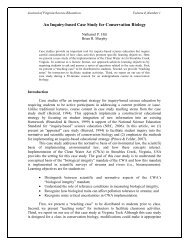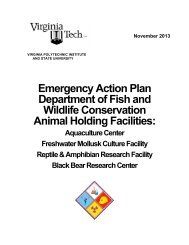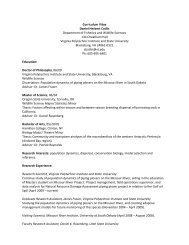An International Journal of Ecology, Evolution and Environment
An International Journal of Ecology, Evolution and Environment
An International Journal of Ecology, Evolution and Environment
Create successful ePaper yourself
Turn your PDF publications into a flip-book with our unique Google optimized e-Paper software.
346 THE AMERICAN MIDLAND NATURALIST 163(2)FIG. 5.—Age-frequency histograms <strong>of</strong> Lemiox rimosus populations in the Clinch <strong>and</strong> Duck rivers; sexratio was 2:1 <strong>and</strong> 3:1 in favor <strong>of</strong> males, respectivelyPopulation trends <strong>and</strong> juvenile recruitment.—Most <strong>of</strong> the live specimens found in both riversbetween 2004 <strong>and</strong> 2007 were <strong>of</strong> small <strong>and</strong> medium sizes, indicating that these populationsare recruiting. Age histograms showed multiple age classes <strong>of</strong> young mussels (1–3 y),collectively comprising about 16% <strong>of</strong> sampled individuals in the Clinch River, <strong>and</strong> about12% in the Duck River (Fig. 4). Furthermore, the time-series <strong>of</strong> historical densities <strong>of</strong> Lemioxrimosus from 1979–2004 reported by Ahlstedt et al. (2004, 2005) indicated stable orincreasing population trends in each river, respectively (Fig. 6). Although these data werecollected using a different sampling design, the protocol was implemented consistently ateach time interval, thus providing additional insights into density trends over longer timeperiods. However, because the protocol sampled areas <strong>of</strong> best available habitat, density mayhave been over-estimated relative to total available habitat. Increasing abundance <strong>of</strong> L.









